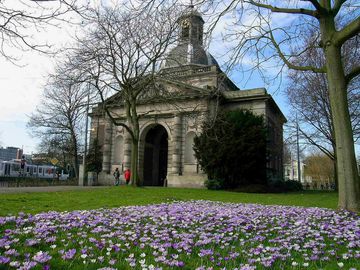

Built by the architect Cornelis Rauws, who lived between 1732 and 1772, the Muiderpoort is one of the few monumental city gates that were built in the Netherlands in the second half of the 18th century. The care taken as to the appearance of classical forms underlines the importance of the gate as an important link between the city and country roads.
The gate possesses two main facades, the city one and the former country one, both differently detailed. The country side displays the ubiquitous Amsterdam coat of arms that bears three St. Andrew crosses. The city side shows a cog ship emblem, which appeared on Amsterdam's coat of arms in medieval times. The passage has a spectacular walled brick cross vault. The two wings of the gate were originally set up for the queuing people and for collecting tolls.
Rauws was known for his great architectural expertise; however, shortly after his appointment as the city architect, on May 11th 1772, he lost his life in a conflagration at the Amsterdamse Schouwburg (the Amsterdam Theatre). This building is considered the only known and independent work of Rauws in Amsterdam.
In 1811, Napoleon and his entourage triumphantly entered Amsterdam through this gate, and promptly demanded food for the ragged French troops. This scene as well as the gate itself is depicted on a canvas hanging at the Amsterdam Historical Museum. In 1963, the building was adapted as an office building and thus, unfortunately, causing the destruction of its original Spartan interior.